Sambar is a hearty and comforting South Indian dish made with protein-rich lentils, seasonal vegetables, aromatic spices, and a signature spice blend called sambar powder. This tangy and spicy stew forms an essential part of South Indian cuisine, and people traditionally slow-cook it to perfection and serve it with rice, idli, dosa, or vada.
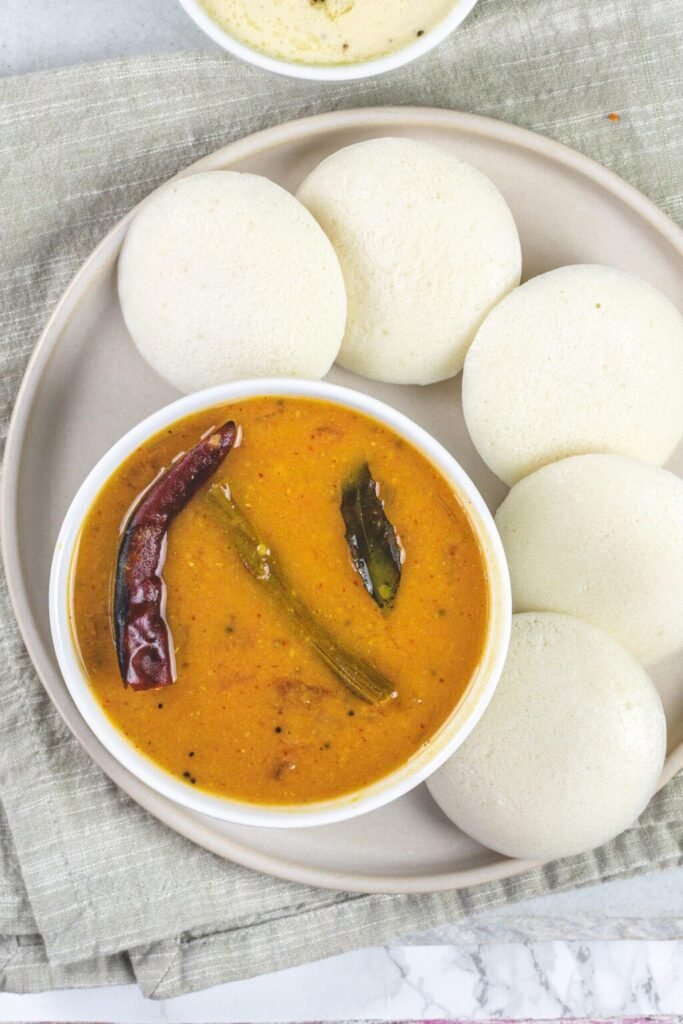
In this modern twist, we’re using the Instant Pot to simplify the cooking process without compromising on flavor. To begin with, this version utilizes the Pot-in-Pot (PIP) method, allowing you to cook lentils and rice simultaneously or prepare other accompaniments while the sambar cooks.
What makes this Instant Pot Sambar special is how quickly it comes together—just 30 minutes from start to finish, with minimal hands-on time.
As the lentils turn soft and creamy, the vegetables retain their texture while absorbing the bold, tangy flavors of tamarind, mustard seeds, curry leaves, and freshly ground spices.
Whether you’re a seasoned fan of South Indian cuisine or trying sambar for the first time, this Instant Pot PIP method is a game-changer. It’s simple, nutritious, and absolutely delicious—perfect for a wholesome Indian meal in a fraction of the usual time.
What Is Sambar?
Sambar brings together toor dal (split pigeon peas), a mix of vegetables like shallots, tomatoes, drumsticks, and eggplant, tangy tamarind pulp, and a unique spice blend called sambar powder to create a wholesome, medium-spiced, and tangy lentil stew infused with rich, aromatic flavors.
Sambar holds a special place in everyday South Indian cuisine, valued not just for its delicious taste but also for its wholesome, soul-satisfying nature.
Over time, sambar’s popularity has spread far beyond South India. Today, it holds a beloved spot in kitchens across the country, with families from all regions preparing their own versions of this classic dish. It’s incredibly versatile and pairs beautifully with a variety of South Indian staples such as steamed rice, fluffy idlis, crispy dosas, hot vadas, and even upma.
What makes sambar truly special is its regional diversity. From Tamil Nadu to Karnataka, Andhra Pradesh to Kerala, every state—and often every household—has its own unique way of preparing sambar.
The variations may include the use of different types of lentils (like moong dal or masoor dal), an assortment of locally available vegetables, or even subtle changes in the ratio of tamarind to jaggery to strike the perfect balance of sourness and sweetness.
Whether you like it thick and chunky or light and soupy, sambar remains a heartwarming and delicious dish that brings both nutrition and nostalgia to the table.
You’ll Love This Sambar Recipe:
- Taste: Mildly spicy with a hint of tanginess, this sambar is rich in bold, layered flavors and carries a distinct, appetizing aroma.
- Texture: The lentils blend smoothly into a thick yet pourable consistency, while the vegetables cook to a tender texture without becoming overly soft or mushy.
- Effortless in the Instant Pot:
- In this simplified version, the vegetables are cooked directly in the Instant Pot liner, while the toor dal (split pigeon peas) is prepared simultaneously using the Pot-in-Pot (PIP) method.
- After cooking, the dal is gently mashed into a smooth consistency and then combined with the cooked vegetables and sambar spice mix. A final aromatic tempering is added at the end to enhance the flavor profile.
- Compared to Traditional Cooking: The conventional way requires cooking the lentils and vegetables separately—dal in a stovetop pressure cooker and veggies in a pot—before combining. This Instant Pot approach merges the process for greater ease and efficiency.
- Fast & Convenient: The entire dish comes together in just 30 minutes, requiring only about 10 minutes of hands-on preparation—perfect for busy days.
- Wholesome & Nourishing: Loaded with protein from lentils and fiber from assorted vegetables, this sambar is not just filling but also rich in antioxidants and easy on the stomach, making it a great addition to your daily diet.
Ingredient Notes:

- Toor Dal (Split Pigeon Peas): Also known as arhar dal or toovar dal, this is the most widely used and traditional choice for making authentic sambar. It cooks down to a creamy texture and adds a nutty, earthy flavor. If toor dal isn’t available, you can substitute it with masoor dal (red lentils), moong dal (yellow lentils), or even a combination of different dals for a slightly different texture and taste.
- Vegetables: For this recipe, I’ve used shallots, tomatoes, and frozen drumsticks. These form the base of the flavor. Notably, sambar is incredibly adaptable and can be prepared using a wide range of vegetables, depending on your taste preferences and seasonal availability, such as:
- Eggplant (brinjal)
- Okra (ladies finger)
- Bottle gourd or ridge gourd
- Carrots
- Pumpkin or ash gourd
- The choice of vegetables significantly influences the taste and aroma, so feel free to use what’s available or what you enjoy most. Though veggies can vary, shallots (or onions) and tomatoes are essential for authentic sambar flavor.
- Sambar Powder: This spice blend is the heart of the dish. I’ve used my homemade sambar masala, which gives an incredibly fresh and aromatic touch. However, if you’re short on time, you can also use a good-quality store-bought sambar powder from your preferred brand. Homemade versions often have a more vibrant flavor profile.
- Tamarind: I use seedless tamarind soaked in hot water, then extract the pulp to bring out the classic tangy flavor of sambar. As an alternative, ready-made tamarind paste works well too—just adjust the quantity according to the brand’s strength.
- Jaggery: A small piece of jaggery is added to subtly balance the tartness from the tamarind. This sweet element doesn’t make the dish sweet—it simply rounds out the flavors beautifully.
Ingredients for Sambar Tadka:

- Oil: The type of oil used can vary by region:
- Coconut oil is commonly used in Kerala for its tropical aroma.
- Sesame oil (gingelly oil) is popular in Tamil Nadu for its deep, earthy flavor.
- Ghee (clarified butter) can also be used for a richer taste and is often preferred in Karnataka and Andhra-style sambar.
- Curry Leaves: Fresh curry leaves are a key ingredient and infuse the tempering with an unmistakable, aromatic flavor. They are a must-have in any authentic sambar recipe.
- Hing (Asafoetida): A small pinch of hing not only enhances the aroma but also aids in digestion. It brings a subtle umami-like depth to the dish.
How To Make Sambar?
Prep:
1) Soak the Tamarind: Start by placing the tamarind in a small bowl and pouring hot water over it. Let it soak for about 10 to 15 minutes, allowing it to soften and release its flavor. While the tamarind is soaking, take this time to wash, peel, and chop the vegetables, and gather the remaining ingredients needed for the sambar preparation.
2) Extract the Tamarind Pulp: Once the tamarind has softened, use your fingers to gently mash and squeeze it, releasing the thick, tangy pulp into the water. This pulp is what will give your sambar its signature sourness. Strain the mixture if needed to remove any fibers or seeds, and set the pulp aside.
3) Prepare the Dal for Pot-in-Pot (PIP) Cooking: Rinse the toor dal (split pigeon peas) thoroughly under running water. It’s best to wash it 2 to 3 times, or until the water runs clear, to remove any surface starch and impurities.
Next, transfer the washed dal into a small steel bowl or container that’s safe for pot-in-pot cooking inside the Instant Pot. Add the required amount of fresh water and a pinch of salt. Give it a good stir and keep it aside as you get the Instant Pot ready for the cooking process.
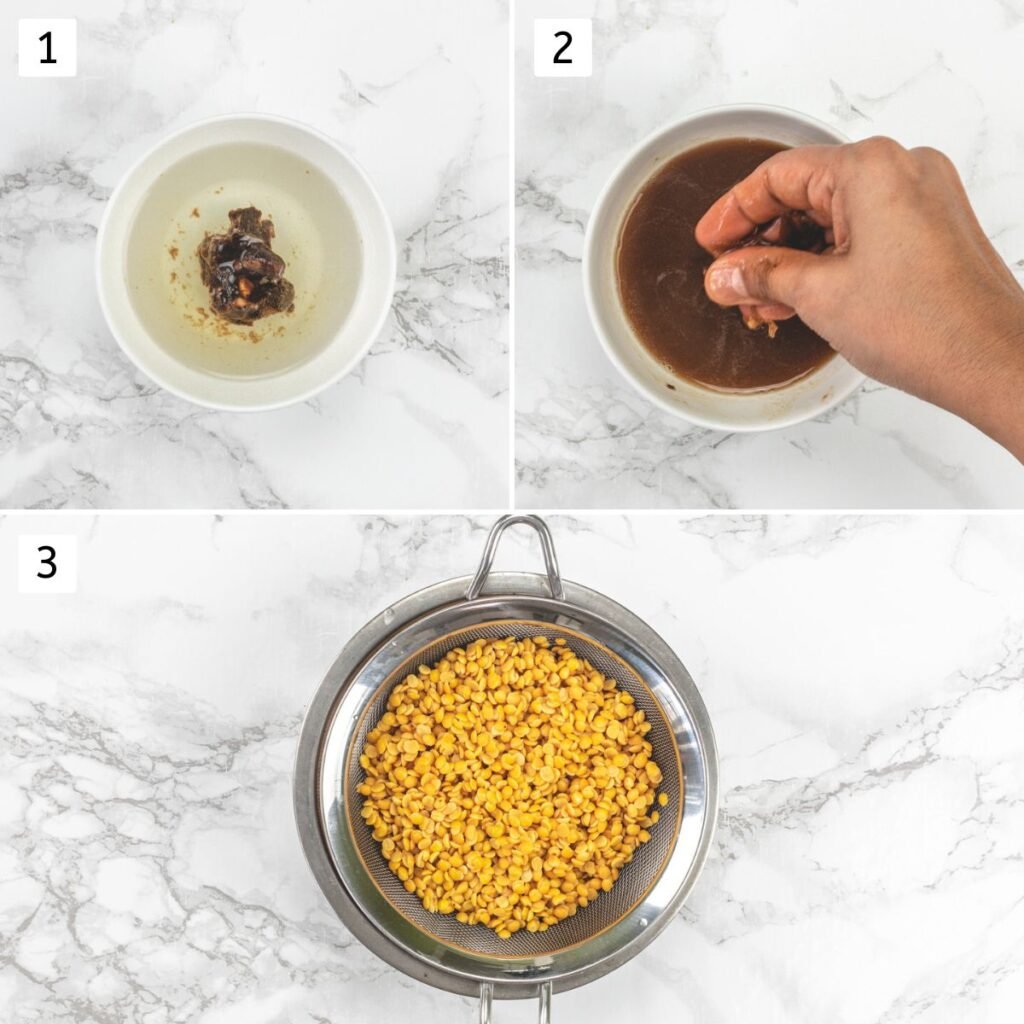
Making Instant Pot Sambar:
1) Start by activating the Sauté mode on your Instant Pot. Once the display reads “HOT”, pour in the oil. Once the oil heats up, sprinkle in a bit of turmeric and add slit green chilies to infuse the oil with flavor. Give it a quick stir—this step helps infuse the oil with flavor right from the beginning.
2) Add chopped shallots, diced tomatoes, and drumsticks. Sauté for about 2 minutes, just until the shallots begin to turn soft and slightly transparent. This helps release their sweetness and enhances the overall base flavor of the sambar.
3) Strain the prepared tamarind pulp directly into the Instant Pot. Hold a small strainer over the pot and pour the soaked tamarind through it to filter out any seeds or fiber. This helps maintain a lump-free, smooth consistency in the finished sambar.
4) Use a spoon to gently press the leftover tamarind pulp through the strainer to extract all the rich juice. Extract as much juice as possible, scraping and pressing the pulp to release every bit of its tangy essence. Discard any leftover solids once done.
5) Sprinkle in salt, red chili powder, and a touch of jaggery over the vegetables. Mix well to ensure the spices are evenly distributed. The jaggery balances the tamarind’s sharp tang with a hint of sweetness, adding depth and harmony to the dish.
6) Pour in enough water to submerge the vegetables, then mix thoroughly to ensure everything is well incorporated. Make sure the veggies are just submerged. Now turn off the Sauté mode, as the base is ready for pressure cooking.
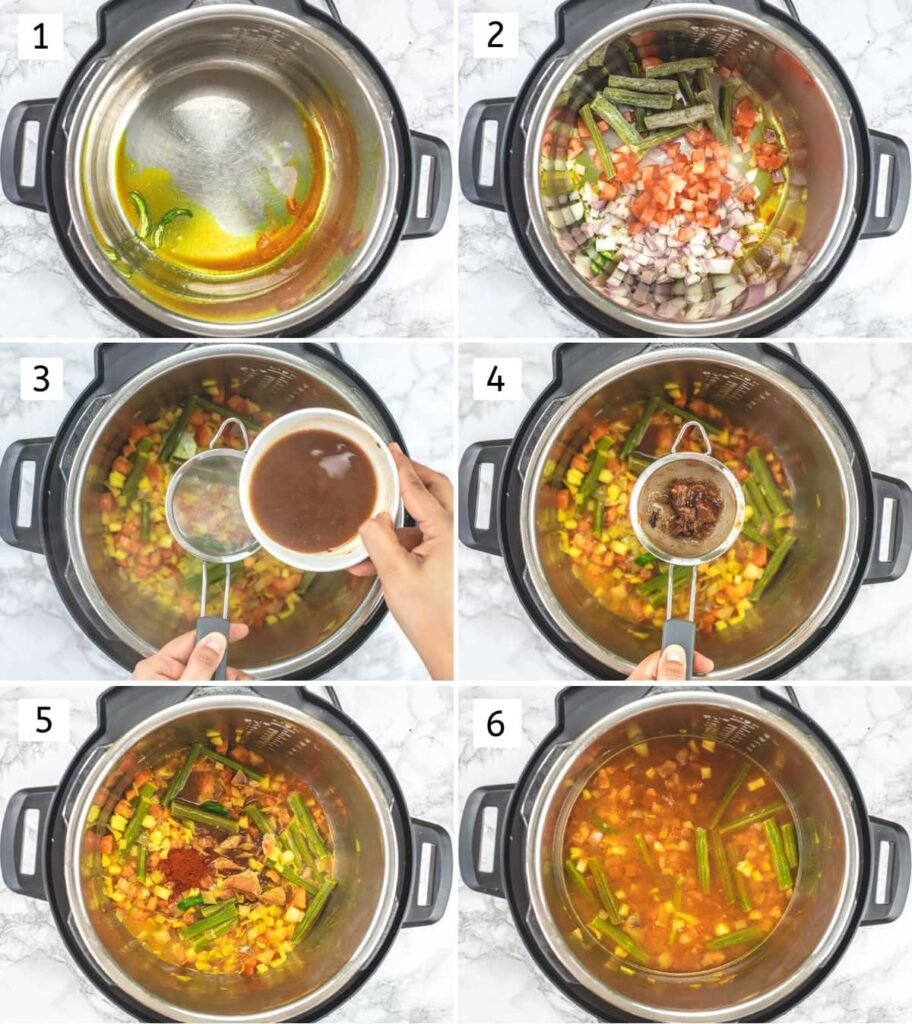
7) Place a tall trivet (stand) in the center of the Instant Pot insert. This will elevate the dal container above the vegetables, allowing both to cook simultaneously.
8) Set the prepared dal container on top of the trivet. Make sure it is stable and positioned securely.
9) Cover the dal container with a lid. This helps prevent splashing and ensures the lentils cook evenly during pressure cooking.
10) Secure the Instant Pot lid and seal the valve. Move the steam release valve to the “Sealing” setting to allow pressure to build up properly for cooking.
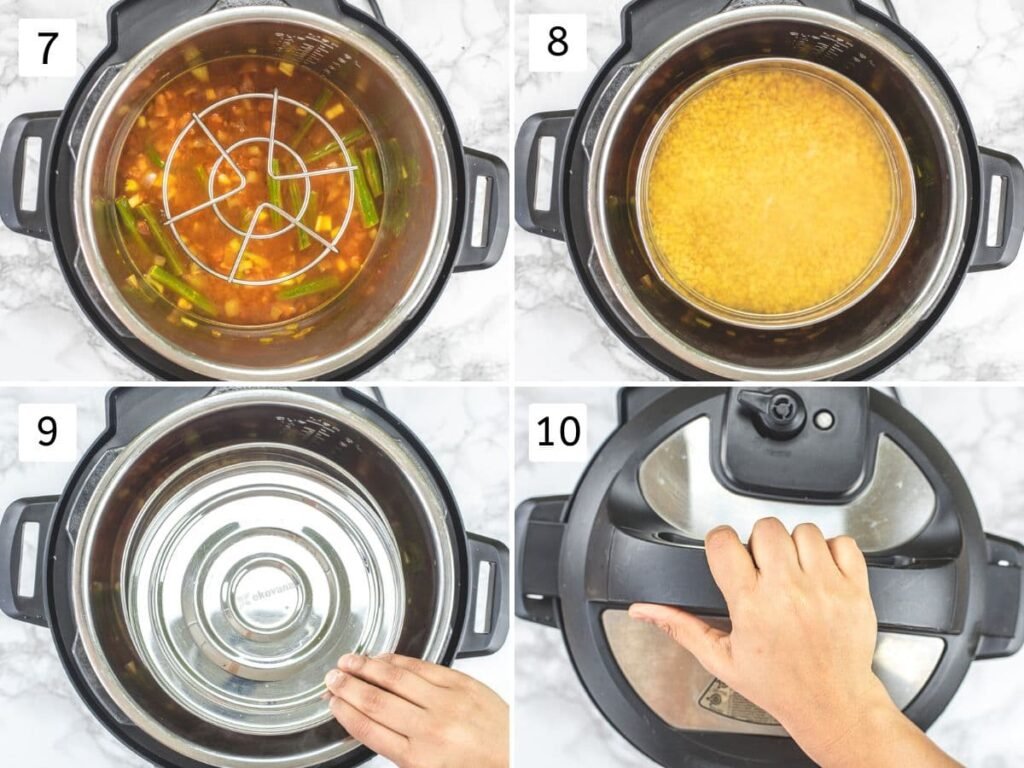
11) Set the Instant Pot to Manual (Pressure Cook) mode. Cook on High Pressure for 8 minutes. Once done, let the pressure release naturally (NPR)—this takes around 10–12 minutes. Allow the pressure to release naturally and open the lid only after the float valve drops down.
12) Gently open the Instant Pot lid and uncover the dal container. Use a hand blender to blend the cooked dal into a smooth, creamy consistency. If you don’t have a blender, use a wire whisk to mash it well. The dal should have a silky, lump-free texture.

13) Take out the dal container and check the vegetables. They should be fully cooked but still hold their shape, not mushy or overdone.
14) Now add the sambar powder to the cooked vegetables in the Instant Pot. Give it a gentle stir to allow the spices to blend well with the tamarind base and cooked veggies.
15) Allow the spice mix to combine thoroughly. This step is key for developing that deep, authentic sambar flavor.
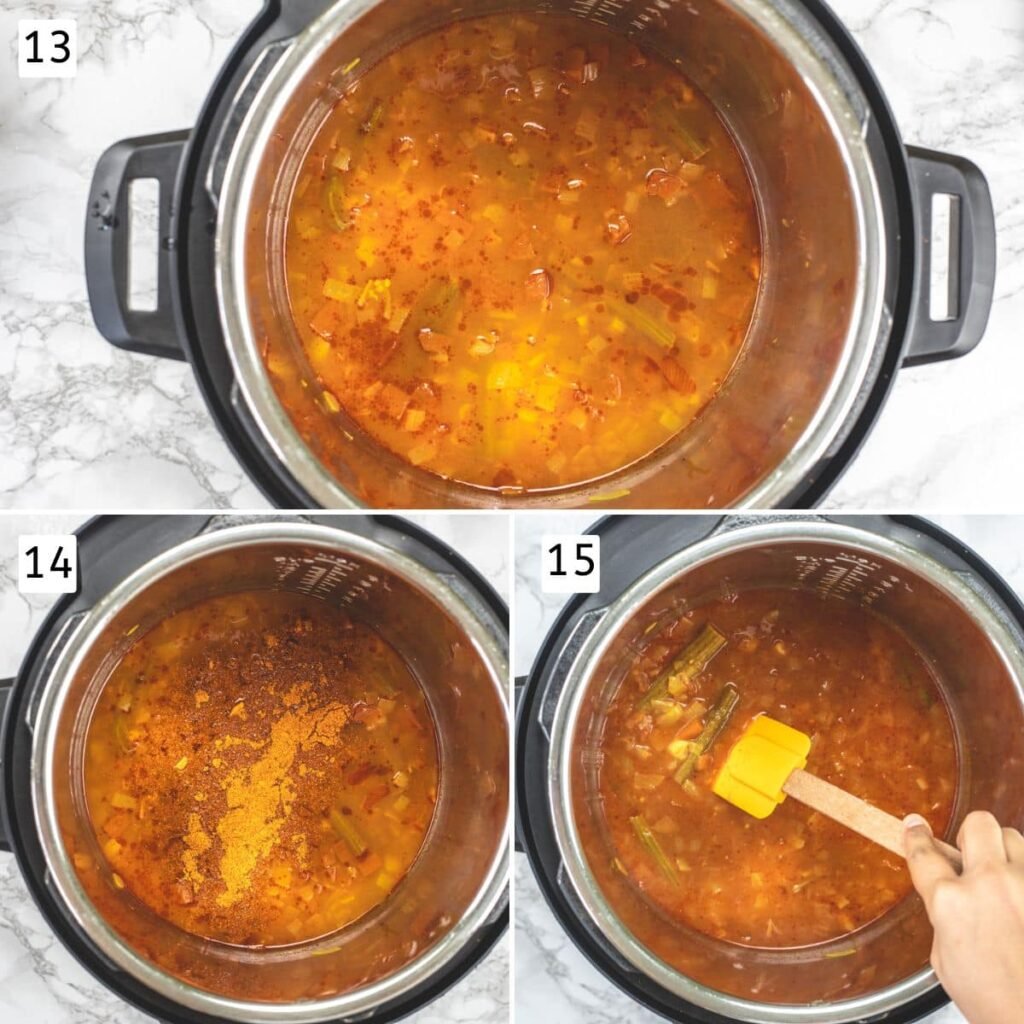
16) Pour the pureed toor dal into the Instant Pot. Mix everything together gently, combining the spiced veggie base and creamy dal into one harmonious stew.
17) Turn the Instant Pot back to Sauté mode. Let the sambar simmer for 5 to 7 minutes so that all the flavors meld beautifully. If the consistency feels too thick, add a bit of hot water to adjust and continue simmering until it reaches your desired texture.

Make Tempering:
1) Start by warming oil in a small tempering pan over medium flame. Once the oil is hot, add fenugreek seeds (methi) and fry them gently. Keep stirring until they turn golden brown and aromatic. Be careful not to burn them, as they can turn bitter quickly.
2) Add mustard seeds to the hot oil. Let them sizzle and pop. This helps release their earthy aroma, creating a flavorful foundation for the South Indian-style tempering.
3) Add a couple of dried red chilies, snapping them in half to release more heat and flavor.
4) Add a generous pinch of hing (asafoetida) along with fresh curry leaves. Be careful while adding curry leaves, as they can cause the hot oil to splutter. These ingredients bring in heat, aroma, and digestive benefits, rounding out the flavor of the tadka.
5) As soon as the curry leaves crisp up and everything is well-fried, pour this hot tempering directly over the cooked sambar.
6) Mix well so that the fragrant oil and spices are fully incorporated into the sambar, infusing it with rich, authentic South Indian flavor.
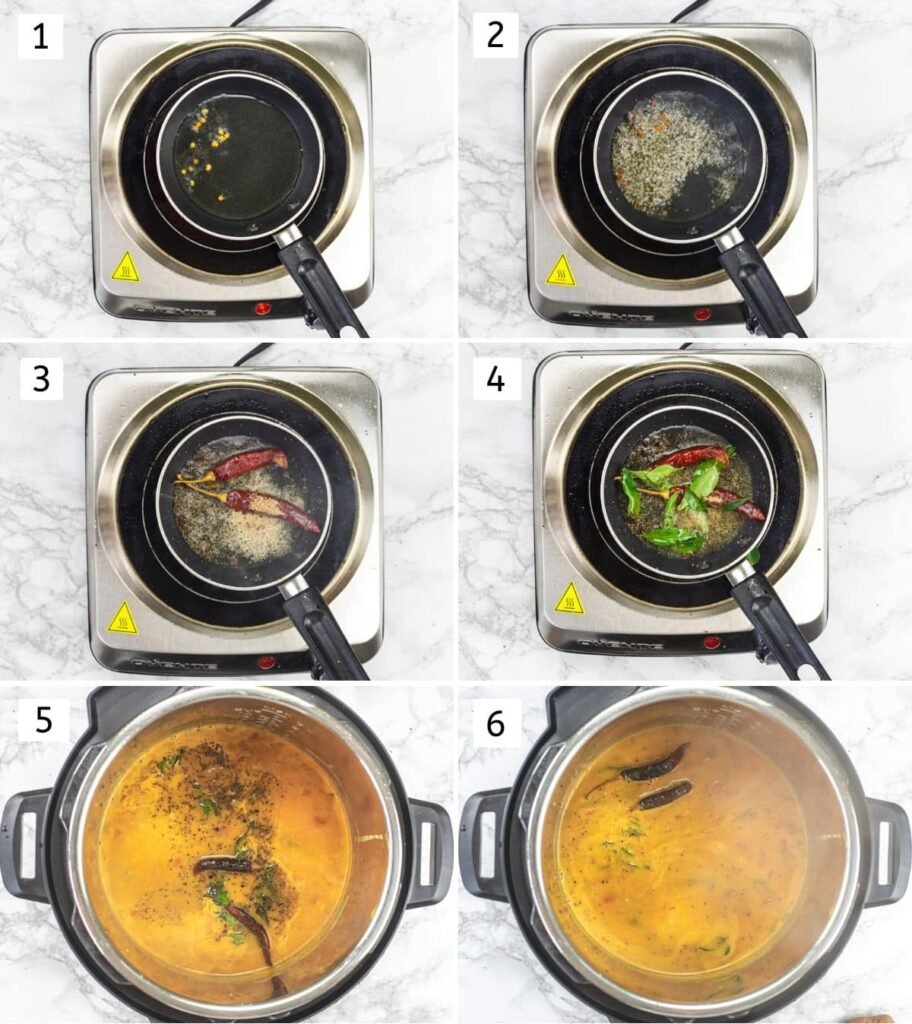
Expert Tips For BEST Sambar Recipe:
1) Use seasonal vegetables for the best flavor and nutrition.
You can include a mix of your favorites, such as okra (bhindi), bottle gourd (lauki), ridge gourd (turai), snake gourd (chichinda), ivy gourd (tendli), pumpkin (kaddu), eggplant (baingan), carrots, green beans, radish (mooli), and potatoes. Each vegetable brings its taste and aroma, so pick combinations that suit your preference.
2) Shallots (or regular onions) and tomatoes are essential.
These two ingredients are the base of a good sambar. Of course, you can experiment with other vegetable combinations, but be sure not to skip these essential ones.
3) Always use fresh toor dal for best results.
Aged or older dal may take much longer to cook and won’t give the same creamy consistency. Fresh dal cooks faster and yields a better texture.
4) Add sambar powder only after pressure cooking.
To preserve its full flavor and aroma, stir in the sambar masala after the vegetables and dal have cooked. High heat during pressure cooking can dull the spices.
5) Adjust the quantity of tamarind based on its age and tartness. In general, freshly dried tamarind tends to be milder, whereas aged tamarind develops a stronger, tangier flavor—so always taste and adjust as needed.
6) If the sambar turns out too tangy, balance it out.
Add a small amount of jaggery or sugar to mellow the acidity and bring harmony to the dish’s flavor profile.

What to serve with sambar?
- To start with, serve it over hot, steamed rice—sambar delivers a warm, comforting taste that’s hard to resist. For this combination, I prefer a thicker consistency—similar to dal fry—so it coats the rice well and feels hearty.
- Enjoy South Indian breakfast items: Sambar is a classic match for idli, dosa, medu vada, masala dosa, uttapam, ven pongal, and more. In such cases, aim for a medium-thick yet pourable texture. This allows soft idlis or crispy vadas to absorb the flavorful sambar, making every bite deliciously moist and tangy.
